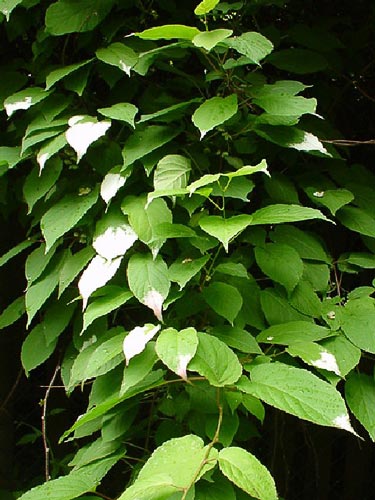Relatives
Actinidia kolomikta (Maxim.) Maxim. - Actinidia kolomikta
Systematic position.
Family Actinidiaceae Hutch. Genera Actinidia Lindl.Synonims.
A. kolomikta var. sugawarana (Koidz.) Worosch. nom. invalid., A. sugawarana Koidz. nom. invalid.Morphology and biology.
Liana. Height is up 2 to 6 m (rarely to 10-15 m), 2 sm in diameter usually (sometimes to 4-5 sm). If there is not support, plant have shape of shrub or crawl. Bark of branches is brown or foxy, bark of old bines is a bit shell. Young bines is biscuit or foxy with not numerous, rounded , light lenticels. Leaf is 5-10 sm length, 4-7 sm width, alternate, entire-kind, petioled. Leafstallk is red downiness. Leaf shape is - elongated- or rounded-oval, ovoid, very often nequilateral, with greatly long pointed apex, leaf base is cordate, nerves of leaf is rarely downy, edge of leaf simple or twice sharp serrate, almost echinated, leaf color is green, tarnished, inconstant (white or crimson on the sun light). Diecious plant. Cross-polinated, entomophilous. Flower is pure white or pinkish, not big, inflorescence of male plants is corymb with 2-3 staminate flowers, pestillate flower is single, white with yellow anther. Fruit is cylindrical, rounded, oval, obtuse, very think green with longitudinal lags, bell of flower is kept before mature. Fruit is to 2,5 sm lenght, to 1,5 sm width. Mass is 1,5-6 g. Flesh of fruit is tender, sweet, aromatic. Fruit consist 60-120 seeds. Mass of 1000 seeds is 0,9 g. Average yield of liana can reach 5-7 kg. Blossoming - middle of June - early in July, ripening - middle of August- end of September. Period of vegetation - 160-180 days. Multiplication - by seeds, by layering, be cutting. Chromosomal number 2n=116Distribution.
Far East : Primorsky district, island Sakhalin, Kuril (Kunashir, Iturup, Moneron), Chabarovsky district, south Amursky district; Japan, Korea, China.Ecology.
Species occurs on good drained rocky soils, grows on mountain slopes to 500-1000 m (max h is 1345 m - south Primorsky district; in north of area max h is 150 m). It grows penumbra site in mixed coniferous-broad-leaved and coniferous forests. It occurs in broad-leaved forests on north slopes, there is not in oak forests. In Sakhalin it grows in edge of montan sparse conifer forest to 200-300 m.Economic value.
Ornamental. Food. Vitaminous (jam, confiture compote, fruit).Related references:
Berestova G.N. Wild populations of actinidia and magnolia-vine in Primorsky district // Bul. of applied bot., gen. and sel., V. 42, fasc.2, p.298-304. L., 1970.Vorobiev D.P. Review of Far East species of genera Actinidia Lindley // Bul. of Gornotaiegny station of Far East Branch of The Academy of Sciences of USSR, Chabarovsk, 1939, V.III, p.5-38.
Woods and shrubs of USSR. M: Mysl, 1966. - 637 p.
Woods and shrubs of USSR. M.-L.: Publ. of The Academy of Sciences of USSR, 1958. - V.IV.- 975 p.
Wild woods and shrubs of Far Earst. L.: Nauka, 1968. - 277 p.
Ermakov B.S. Forest plants in your garden. M.: Ecologia,1992.
Kolbasina E.I. Actinidia and magnolia-vine in Russia (biology, introduction, selection). M., 2000. - 264 p.
Osipova N.V. Lianas. M., 1989.
Plechanova M.N. Actinidia, magnolia-vine, honeysuckle. L.: Agropromisdat, 1990. - 87 p.
Titljanov A.A. Some problems of Actinidia investigation in Soviet Prymorie // Bul. of V.L. Komarov Botanic Institute of The Academy of Sciences of USSR. Ser. VI, fasc.7, p.149-151. L, 1959.
Flora USSR. M.-L.: Publ. of The Academy of Sciences of USSR, 1949. - V.XV.
Jakovlev-Sibirjak I.I. Actinidia. M.: Selchozgiz, 1952. - 40 p.


